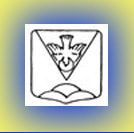|
Last week my mother taught me a new word: “umbraphile.” An umbraphile is someone who loves eclipses. Last week was a good one for umbraphiles, including a friend of mine who drove seven hours round trip to Vermont to experience eclipse “totality.” My friend assured me it was worth the trip.
I declined the opportunity to go to Vermont with my friend, and I don’t regret that decision. But I almost missed the eclipse altogether, and I would have regretted that. Thankfully Carrie, who knows me well, texted me at 3:00 on Monday afternoon to tell me to go outside. When I first went outside, I couldn’t see that anything was happening. Maybe it wasn’t quite as bright and sunny as normal, but the difference was too subtle for me to notice. And then I put on my magic protective plastic glasses, looked up at the sun, and it was perfectly clear. The moon was already about halfway across the sun. I just hadn’t seen it. I hadn’t had eyes to see. Or, more accurately, I hadn’t had on the glasses that I needed to be able to see. For the next 45 minutes, I sat in my backyard and watched the moon cross in front of the sun, without burning my eyes out. Watching the eclipse was good preparation for this morning’s Gospel reading, which is all about seeing. We are still on the first Easter day. By this time, the disciples know the tomb is empty, and they have heard reports about the resurrection. Presumably they are on the alert for the resurrected Jesus. But most of them have not yet seen the resurrected Jesus. Suddenly, this is where our reading picks up, there Jesus is, in their midst, in the flesh. And, it turns out, the disciples are not ready to see Christ. When Christ appears to them on that first Easter, they react with misunderstanding and with terror. The disciples think they are seeing a ghost. The disciples have a seeing problem. To see properly, to see Christ, even right there in front of them, the disciples need help. They were like me when I first went outside last Monday. They do not have eyes to see. Jesus encourages them. “Look,” Jesus says. “See that it is I myself. Touch me and see.” Jesus invites the disciples to see him, to see beyond their doubts and fears to the good news that Christ really is risen and is with them at that very moment. The disciples still aren’t there. The disciples still can’t quite believe their eyes. They feel the joy of Christ’s resurrection. But, Luke tells us, “they were [also] disbelieving and still wondering.” Jesus gives the disciples a little more help. Jesus reminds the disciples that he is the fulfilment of the law, the prophets, and the Psalms. Jesus opens the disciples’ minds to understand the Scriptures, to see Christ in the Bible and to use the Bible to makes sense of Christ who is standing right there in front of him. And this time it sticks. Jesus commissions the disciples as witnesses and, in another few verses, we read that they worshipped Christ with joy. No more terror or disbelief for them. Jesus has moved the disciples from not seeing him at all, to sort of seeing him, to seeing him for who he is, seeing him with genuine understanding and joy. We need that same kind of help. Back to the eclipse. While taking a break from staring at the sun, I saw a man walking his dog on my street, apparently oblivious to the eclipse that was happening at that very minute. I thought, there but for the grace of Carrie go I. And I thought, how often am I like that man? How often do I go about my life, totally oblivious to the things happening all around me? I didn’t have to think long. Friday a week ago, I was having tea with a friend—the same friend who went to Vermont for the totality, as it happens. We were talking about math, of all things. And an earthquake happened. Without me noticing. I only learned about the earthquake I had just experienced when my niece texted our whole family. Now, I seem to be more clueless than most people. I definitely need help if I am going to see even the most dramatic things happening right around me. So, I totally get the difficulty the disciples had in coming on board with the resurrection, even when Jesus was standing right in front of them. I, too, need time and guidance to see, people to draw my attention to things. But just noticing things is not yet enough. As people of faith, we are invited to see more deeply, to see through created things to their creator. Jim Shields is the one who helped me with this on the eclipse. Jim explained to me that eclipses work, so to speak, only because the moon is exactly the right size and distance from the earth to block the sun, given its size and distance from the earth. Change the distance from the earth or the size of either the sun or the moon, and eclipses would be a lot less impressive. Jim told me that perfect coordination of sun and moon in eclipses are evidence of God’s providence. Jim could see God at work in the eclipse. So, for me to appreciate the eclipse properly, to see the eclipse and to see God at work in the eclipse, I needed my friend to inspire me in the first place. I needed Carrie to remind me to go outside. I needed protective glasses to make the eclipse visible. And I needed Jim to point out the theological significance of what I saw. It takes a village for me to know what is happening right around me. Hopefully most of you are not as blind as I am. But we all need help seeing. I want to return to our passage one more time. When Jesus’ presence and his words are not enough for the disciples, Jesus points them to Scripture. In our passage, Scripture is what helps the disciples to see Christ for who he is. Scripture is like the magic protective glasses that made it possible to see the eclipse. Spending time in Scripture sensitives us to God’s hand at work in the world around us. Spending time in Scripture inclines us to look for Christ, and helps us to see Christ. Nearly a century ago, a theologian famously said that he held a newspaper in one hand and the Bible in the other. His point was that we need to know what is happening in our world—that’s why we read newspapers. Today the theologian would probably say a newsfeed. We hold the Bible in the other hand so that we know how to interpret what is happening in our world. For this theologian, the Bible was like eclipse glasses helping us to see God in the news. (We can say the same for prayer and worship and for acts of loving service in Christ’s name.) We need the help of our various spiritual practices if we are going to notice our risen Lord standing right in front of us, and have any true hope of recognizing him for who he is. And so I encourage you to take advantage of the “glasses” that our tradition makes available to us. In particular, spend time in Scripture so that you can respond with understanding and joy, not disbelief, whenever Christ appears in our midst. And I make that invitation in Christ’s name. Amen.
1 Comment
Mary Moore
4/17/2024 12:57:32 pm
What an apt analogy. That it took 3 other people to make your eclipse experience more complete reminds me of how the contemplative prayer group works the same way. Everyone adds a little more to the interpretation of the particular reading.
Reply
Leave a Reply. |
Rector
Rev. Dr. Harvey Hill Third Order Franciscan Archives
July 2024
Categories |


 RSS Feed
RSS Feed
